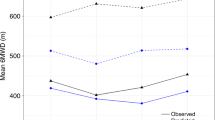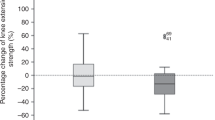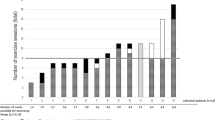Abstract
This study assessed the functional capacity of sub-acute SCT recipients using validated physical performance tests, including 6-min walk distance, repeated sit-to-stand time and 50-ft walk time, and compared these outcomes with those reported for a heterogeneous oncology population. The medical records of 80 consecutive sub-acute SCT recipients not receiving corticosteroids were retrospectively reviewed for demographic, medical and anthropometric information, and outcomes for these physical performance tests administered at the time of initial physiotherapy evaluation. Measures of central tendency, 95% confidence intervals, unpaired t-tests and correlation coefficients were calculated using a SPSS statistical package. SCT recipients completed the 50-ft walk in 10.66±4.43 s, repeated sit-to-stand trial in 4.16±1.82 s and walked 400.2 m in 6 min. For the timed tests, SCT recipients were approximately twice as fast as a heterogeneous group of oncology patients and walked approximately 50% further in 6 min. No overlap in the 95% confidence intervals for the two groups was observed for any of the tests. These results (1) suggest that reference values describing the functional capacity of a heterogeneous oncology population underestimate the functional capacity of SCT recipients and (2) provide clinically useful reference values for assessing functional capacity of sub-acute SCT recipients referred for physiotherapy.
This is a preview of subscription content, access via your institution
Access options
Subscribe to this journal
Receive 12 print issues and online access
$259.00 per year
only $21.58 per issue
Buy this article
- Purchase on Springer Link
- Instant access to full article PDF
Prices may be subject to local taxes which are calculated during checkout




Similar content being viewed by others
References
Wiskemann J, Huber G . Physical exercise as adjuvant therapy for patients undergoing hematopoietic stem cell transplantation. Bone Marrow Transplant 2008; 41: 321–329.
Hacker ED, Ferrans C, Verlen E, Ravandi F, van Besien K, Gelms J et al. Fatigue and physical activity in patients undergoing hematopoietic stem cell transplant. Onc Nurs Forum 2006; 33: 614–624.
Dimeo FC, Stieglitz RD, Novelli-Fischer U, Fetscher S, Keul J . Effects of physical activity on the fatigue and psychologic status of cancer patients during chemotherapy. Cancer 1999; 85: 2273–2277.
Giralt S, Simmonds M, Smith R . Measures of morbidity: functional assessment and cytokines. Biol Blood Marrow Transplant 2007; 13: 98–102.
Jarden M, Hovgaard D, Boesen E, Quist M, Adamsen L . Pilot study of a multimodal intervention: mixed-type exercise and psychoeducation in patients undergoing allogeneic stem cell transplantation. Bone Marrow Transplant 2007; 40: 793–800.
Simmonds MJ . Physical function in patients with cancer: psychometric characteristics and clinical usefulness of a physical performance test battery. J Pain Symptom Manage 2002; 24: 404–414.
Montoya M, Fossella F, Palmer JL, Kaur G, Pace EA, Yadav R et al. Objective evaluation of physical function in patients with advanced lung cancer: a preliminary report. J Palliative Med 2006; 9: 309–316.
Basen-Engquist K, Carmack Taylor CL, Rosenblum C, Smith MA, Shinn EH, Greisinger A et al. Randomized pilot test of a lifestyle physical activity intervention for breast cancer survivors. Patient Educ Couns 2006; 64: 225–234.
Overcash JA, Rivera Jr HR . Physical performance evaluation of older cancer patients: a preliminary study. Crit Rev Oncol Hematol 2008; 68: 233–241.
Oldervoll LM, Loge JH, Paltiel H, Asp MB, Vidvei U, Wiken AN et al. The effect of a physical exercise program in palliative care: a phase II study. J Pain Symptom Manage 2006; 31: 421–430.
Rothstein JM, Echternach JL . Primer on Measurement: An Introductory Guide to Measurement Issues. American Physical Therapy Association: Alexandria, VA, 1993, 46–54.
ATS Committee on Proficiency Standards for Clinical Pulmonary Function Laboratories. ATS statement: Guidelines for the six-minute walk test. Am J Respir Crit Care Med 2002; 166: 111–117.
World Health Organization. Obesity: Preventing and Managing the Global Epidemic. WHO Technical Reports Series. No 894. WHO: Geneva, 1998, pp 8–9.
Enright PE, Sherrill DL . Reference equations for the six-minute walk in healthy adults. Am J Respir Crit Care Med 1998; 158: 1384–1387.
Enright PL, McBurnie MA, Bittner V, Tracy RP, McNamara R, Arnold A et al. The 6-min walk test. A quick measure of functional status in elderly adults. Chest 2003; 123: 387–398.
Csuka M, McCarty DJ . Simple method for measurement of lower extremity muscle strength. Am J Med 1985; 78: 77–81.
Jette DU, Halbert J, Iverson C, Miceli E, Shah P . Use of standardized outcome measures in physical therapist practice: perceptions and applications. Phys Ther 2009; 89: 125–135.
Humpel N, Iverson DC . Review and critique of the quality of exercise recommendations for cancer patients and survivors. Support Care Cancer 2005; 13: 493–502.
Hayes SC, Davies PS, Parker TW, Bashford J, Green A . Role of a mixed type, moderate intensity exercise programme after peripheral blood stem cell transplantation. Br J Sports Med 2004; 38: 304–309.
Dimeo FC, Tilmann MH, Bertz H, Kanz L, Mertelsmann R, Keul J . Aerobic exercise in the rehabilitation of cancer patients after high dose chemotherapy and autologous peripheral stem cell transplantation. Cancer 1997; 79: 1717–1722.
DeFor TE, Burns LJ, Gold E-MA, Weisdorf DJ . A randomized trial of the effect of a walking regimen on the functional status of 100 adult allogeneic donor hematopoietic cell transplant patients. Biol Blood Marrow Transplant 2007; 13: 948–955.
Bohannon RW . Six-minute walk test: a meta-analysis of data from apparently healthy elders. Top Geriatr Rehab 2007; 23: 155–160.
Carter R, Holiday DB, Nwasuruba C, Stocks J, Grothues C, Tiep B . 6-min walk work for assessment of functional capacity in patients with COPD. Chest 2003; 123: 1408–1415.
Ingle L, Rigby AS, Nabb S, Jones PK, Clark AL, Cleland JG . Clinical determinants of poor six-minute walk test performance in patients with left ventricular systolic dysfunction and no major structural heart disease. Eur J Heart Fail 2006; 8: 321–325.
Courneya KS, Keats MR, Turner AR . Physical exercise and quality of life in cancer patients following high dose chemotherapy and autologous bone marrow transplantation. Psychooncology 2000; 9: 127–136.
Guyatt GH, Sullivan MJ, Thompson PJ, Fallen EL, Pugsley SO, Taylor DW et al. The 6-min walk: a new measure of exercise capacity in patients with chronic heart failure. Can Med Assoc J 1985; 132: 919–923.
Reidelmeyer DA, Bayoumi AM, Goldstein RS, Guyatt GH . Interpreting small differences in functional status: The six-minute walk test in chronic lung disease patients. Am. J Respir Crit Care Med 1997; 155: 1278–1282.
Ryan GC, Gray H, Newton M, Granat MH . The convergent validity of free-living physical activity monitoring as an outcome measure of functional ability in people with chronic low back pain. J Back Musculoskelet Rehab 2008; 21: 137–142.
Lee HJ, Oran B, Saliba RM, Couriel DM, Shin K, Massey P et al. Steroid myopathy in patients with acute graft-versus-host disease treated with high-dose steroid therapy. Bone Marrow Transplant 2006; 38: 299–303.
Affi AK, Bergman RA, Harvey JC . Steroid myopathy. Clinical, histologic and cytologic observations. Johns Hopkins Med 1968; 123: 158–174.
Decramer M, De Bock V, Dom R . Functional and histologic picture of steroid-induced myopathy in chronic obstructive pulmonary disease. Am J Respir Crit Care Med 1996; 153: 1958–1964.
Acknowledgements
The authors wish to express their deep appreciation to the patients and caregivers for their commitment to this program. The authors would also like to acknowledge the efforts of the entire staff of the Ambulatory Treatment Center, the patient care provided by Shammi J Venkatachalam, PT, Nagma Ahmed, PT and BJ Jackson, the editorial assistance provided by Nancy Paddison, PTA, BA, and the graphing assistance of Sijin Wen.
Author information
Authors and Affiliations
Corresponding author
Rights and permissions
About this article
Cite this article
Morris, G., Brueilly, K., Scheetz, J. et al. Functional performance status of hematopoietic SCT recipients in the sub-acute phase of recovery. Bone Marrow Transplant 45, 755–761 (2010). https://doi.org/10.1038/bmt.2009.232
Received:
Revised:
Accepted:
Published:
Issue Date:
DOI: https://doi.org/10.1038/bmt.2009.232
Keywords
This article is cited by
-
Functional capacity, pulmonary function, and quality of life in hematopoietic stem cell transplantation survivors
Supportive Care in Cancer (2021)
-
Adherence of stem cell transplant recipients receiving glucocorticoid therapy to an exercise-based rehabilitation program
Supportive Care in Cancer (2012)



